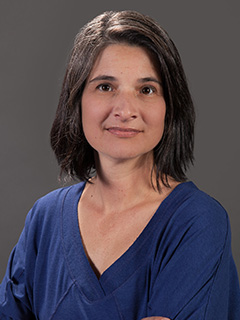2012 New Investigators Research Grant
Seeking Evidence Beyond the Bells and Whistles

Anna Sosa’s recent research interest was decided by a question for which she had no answer. Several years ago, when Sosa was supervising graduate students at the Northern Arizona University (NAU) Speech-Language-Hearing Clinic, the mother of a two-year-old she had been treating asked if she’d recommend buying the electronic toy promoted as an aid to language development. Sosa responded as best she was able but realized that she really couldn’t answer based on any concrete evidence. There was none. Then, shortly later, a former student working in home-based early intervention called with another question. She had noticed that one of her families seemed to have only electronic toys in their home and she wanted to know if there was any research into the influence of these toys on interaction, play, and language development. Again, no evidence.
Sosa would change that. In 2012 the ASHFoundation awarded her a New Investigators Research Grant for her project, “Caregiver-Infant Communicative Interaction During Play.” Surrounded as we all are by the glitter of electronic toys and mobile media, do we really know how these technologies are affecting us? “As communication professionals,” says Sosa, “especially those of us who work with young children, we need to raise awareness of the potential negative effects of the increasing use of electronics. For the last several years I’ve seen many presentations and articles about using technology in our work but little or nothing about their dangers. There may be benefits from our using carefully designed technologies but we should proceed with caution and base our decisions on evidence and not attractive bells and whistles.”
To gather that evidence Sosa used small audio recorders placed in vests worn by infants to record play sessions involving the infants and their parents. The parents and babies played with books, traditional toys, and electronic toys in their own homes over the course of three days. The play sessions were then transcribed and different aspects of the interaction and the language used by the parents were counted. It turns out that parents talk a lot less and are less responsive to their babies’ babbles when they are playing with electronic toys.
Sosa’s work received a great deal of national and international attention in the media and resulted in interviews and appearances as well as invitations to participate in local efforts to support families with young children. Also, adds Sosa, “I think the ASHFoundation grant contributed to my receiving an R03 research award from the National Institutes of Health. Reviewers at the time noted that the ASHFoundation’s belief in my work added considerably to the strength of my application. The grant also fostered in me, personally, a deep appreciation of the importance of the ASHFoundation’s work. I’ve come to realize that even relatively small awards can have a great impact on the awardee and potentially result in major breakthroughs in the field.”
So what does the future hold for Sosa, who is currently an associate professor in the Department of Communication Sciences and Disorders and director of the Child Speech and Language Lab at NAU? “I hope to continue contributing to the knowledge base regarding the impact of everyday activities, including the use of electronics and mobile media devices, on the communication development of children with and without communication disorders. I also hope to use different research methodologies to investigate the learning—or lack of learning—that actually occurs during various activities and interactions.” The ultimate objective of her research, says Sosa, is to “improve the effectiveness and efficiency of our interventions with young children with communication disorders and their families.”
View More Recipient Spotlights